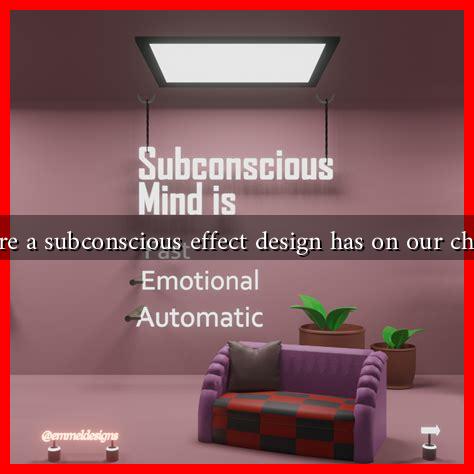-
Table of Contents
Is There a Subconscious Effect Design Has on Our Choices?
Design is everywhere, from the products we use to the websites we visit and the advertisements we encounter. While we often think of design as a purely aesthetic choice, it plays a crucial role in influencing our decisions on a subconscious level. This article explores how design impacts our choices, the psychological principles behind it, and real-world examples that illustrate these effects.
The Psychology of Design
At its core, design is about communication. It conveys messages, evokes emotions, and guides behavior. The subconscious mind processes design elements in ways that we may not even be aware of. Here are some psychological principles that explain how design influences our choices:
- Color Psychology: Colors evoke specific emotions and associations. For instance, red can stimulate excitement and urgency, while blue often conveys trust and calmness. Brands like Coca-Cola use red to create a sense of urgency, while banks often use blue to instill trust.
- Visual Hierarchy: The arrangement of elements on a page can guide attention and influence decision-making. A well-structured layout can lead users to prioritize certain information over others, affecting their choices.
- Familiarity and Comfort: Designs that are familiar to us can create a sense of comfort and ease. This is why many websites and apps follow similar design patterns; they reduce cognitive load and make navigation intuitive.
Case Studies: Design in Action
To understand the subconscious effects of design, let’s look at some compelling case studies that highlight its impact on consumer behavior.
1. The Impact of Website Design on E-commerce
A study conducted by the Stanford Persuasive Technology Lab found that 75% of users judge a company’s credibility based on its website design. This statistic underscores the importance of aesthetics in online shopping. For example, a well-designed e-commerce site with high-quality images and a clean layout can lead to increased sales. In contrast, a cluttered or outdated site can deter potential customers.
2. The Power of Packaging Design
Packaging is another area where design plays a crucial role. A study by the Journal of Marketing Research found that consumers are willing to pay more for products with attractive packaging. For instance, Apple’s minimalist packaging design not only enhances the unboxing experience but also reinforces the brand’s premium image, influencing consumers to choose Apple products over competitors.
Statistics That Speak Volumes
Several statistics highlight the profound impact of design on consumer choices:
- According to a report by Adobe, 38% of people will stop engaging with a website if the content or layout is unattractive.
- A study by HubSpot found that 93% of consumers focus on visual appearance when making purchasing decisions.
- Research from the Nielsen Norman Group indicates that users form an opinion about a website in just 50 milliseconds, emphasizing the importance of first impressions.
Designing for Influence
Understanding the subconscious effects of design can empower businesses and individuals to make more informed choices. Here are some strategies to consider when designing for influence:
- Utilize Color Wisely: Choose colors that align with the emotions you want to evoke in your audience.
- Create Clear Visual Hierarchies: Use size, contrast, and spacing to guide users’ attention to key information.
- Prioritize User Experience: Ensure that your design is intuitive and user-friendly to reduce cognitive load and enhance engagement.
Conclusion
Design is not just about aesthetics; it is a powerful tool that influences our subconscious choices. From color psychology to visual hierarchy, the elements of design can significantly impact how we perceive brands and make decisions. By understanding these principles, businesses can create more effective designs that resonate with their audience and drive engagement. As we continue to navigate a world saturated with design, recognizing its subconscious effects can lead to more informed choices, both as consumers and creators.
For further reading on the psychology of design, you can explore resources like Nielsen Norman Group and Adobe’s Experience Design.


